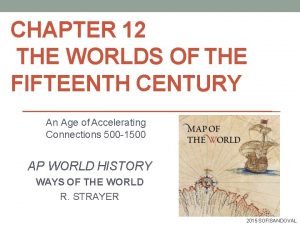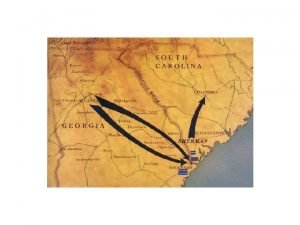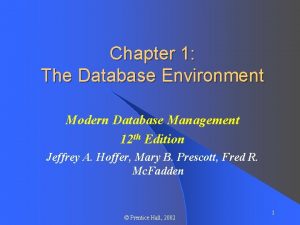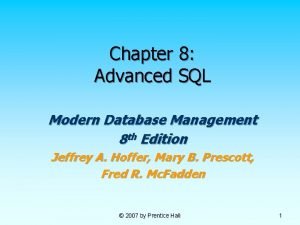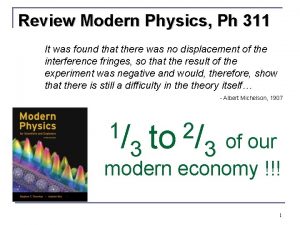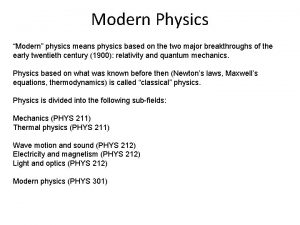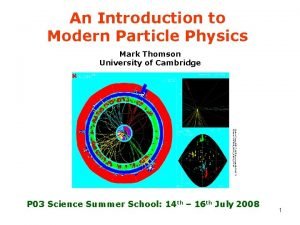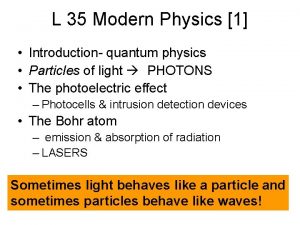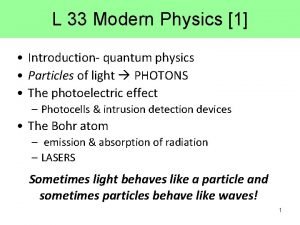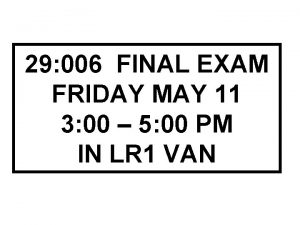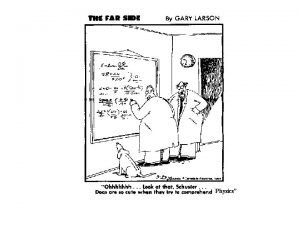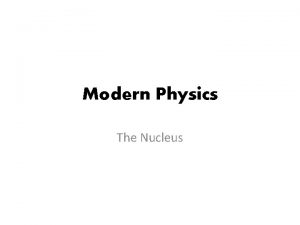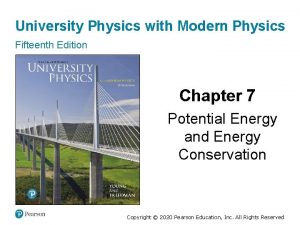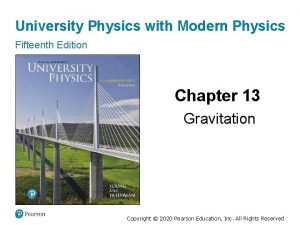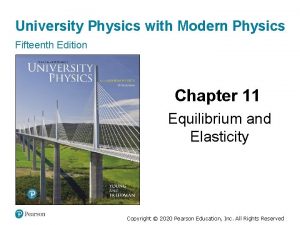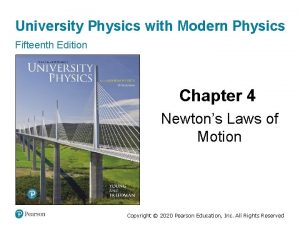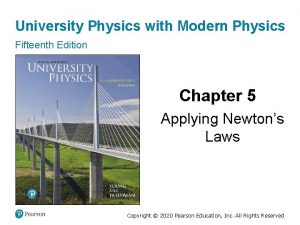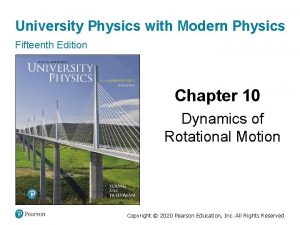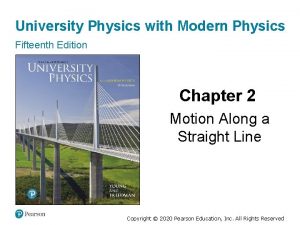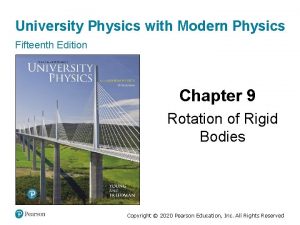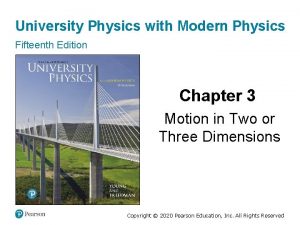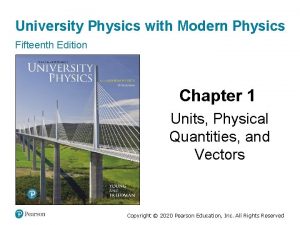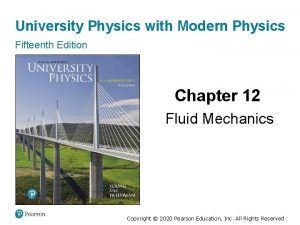University Physics with Modern Physics Fifteenth Edition Chapter






























- Slides: 30

University Physics with Modern Physics Fifteenth Edition Chapter 6 Work and Kinetic Energy Copyright © 2020 Pearson Education, Inc. All Rights Reserved

Learning Outcomes In this chapter, you’ll learn… • what it means for a force to do work on an object, and how to calculate the amount of work done. • The definition of the kinetic energy (energy of motion) of an object, and how the total work done on an object changes the object’s kinetic energy. • How to use the relationship between total work and change in kinetic energy when the forces are not constant, the object follows a curved path, or both. • how to solve problems involving power (the rate of doing work). Copyright © 2020 Pearson Education, Inc. All Rights Reserved

Introduction • A baseball pitcher does work with his throwing arm to give the ball a property called kinetic energy. • In this chapter, the introduction of the new concepts of work, energy, and the conservation of energy will allow us to deal with problems in which Newton’s laws alone aren’t enough. Copyright © 2020 Pearson Education, Inc. All Rights Reserved

Work • A force on an object does work if the object undergoes a displacement. These people are doing work as they push on the car because they exert a force on the car as it moves. Copyright © 2020 Pearson Education, Inc. All Rights Reserved

Units of Work • The SI unit of work is the joule (named in honor of the 19 th-century English physicist James Prescott Joule). • Since W = Fs, the unit of work is the unit of force multiplied by the unit of distance. • In SI units: 1 joule = (1 newton) (1 meter) or 1 J = 1 N ∙ m • If you lift an object with a weight of 1 N a distance of 1 m at a constant speed, you do 1 J of work on it. Copyright © 2020 Pearson Education, Inc. All Rights Reserved

Work Done by a Constant Force (1 of 2) • The work done by a constant force acting at an angle to the displacement is: • This can be written more compactly as: Copyright © 2020 Pearson Education, Inc. All Rights Reserved

Positive Work • When the force has a component in the direction of the displacement, work is positive. Copyright © 2020 Pearson Education, Inc. All Rights Reserved

Negative Work • When the force has a component opposite to the direction of the displacement, work is negative. Copyright © 2020 Pearson Education, Inc. All Rights Reserved

Zero Work (1 of 2) • When the force is perpendicular to the direction of the displacement, the force does no work on the object. Copyright © 2020 Pearson Education, Inc. All Rights Reserved

Zero Work (2 of 2) • A weightlifter does no work on a barbell as long as he holds it stationary. Copyright © 2020 Pearson Education, Inc. All Rights Reserved

Lowering the Barbell to the Floor: Slide 1 Copyright © 2020 Pearson Education, Inc. All Rights Reserved

Lowering the Barbell to the Floor: Slide 2 Copyright © 2020 Pearson Education, Inc. All Rights Reserved

Lowering the Barbell to the Floor: Slide 3 Copyright © 2020 Pearson Education, Inc. All Rights Reserved

Total Work • The work done by the net force on a particle as it moves is called the total work Wtot. • The particle speeds up if Wtot > 0, slows down if Wtot < 0, and maintains the same speed if Wtot = 0. • Video Tutor Solution: Example 6. 2 Copyright © 2020 Pearson Education, Inc. All Rights Reserved

Kinetic Energy (1 of 4) • The energy of motion of a particle is called kinetic energy: • Like work, the kinetic energy of a particle is a scalar quantity; it depends on only the particle’s mass and speed, not its direction of motion. • Kinetic energy can never be negative, and it is zero only when the particle is at rest. • The SI unit of kinetic energy is the joule. Copyright © 2020 Pearson Education, Inc. All Rights Reserved

Kinetic Energy (2 of 4) • Kinetic energy does not depend on the direction of motion. Copyright © 2020 Pearson Education, Inc. All Rights Reserved

Kinetic Energy (3 of 4) • Kinetic energy increases linearly with the mass of the object. Copyright © 2020 Pearson Education, Inc. All Rights Reserved

Kinetic Energy (4 of 4) • Kinetic energy increases with the square of the speed of the object. Copyright © 2020 Pearson Education, Inc. All Rights Reserved

The Work-Energy Theorem • The work-energy theorem: The work done by the net force on a particle equals the change in the particle’s kinetic energy. Copyright © 2020 Pearson Education, Inc. All Rights Reserved

Work and Kinetic Energy in Composite Systems • The work done by the external forces acting on the skater is zero. • But the skater’s kinetic energy changes nonetheless! • The explanation is that it’s not adequate to represent the boy as a single point mass. • Video Tutor Solution: Example 6. 5 Copyright © 2020 Pearson Education, Inc. All Rights Reserved

Work and Energy with Varying Forces (1 of 3) • Many forces are not constant. • Suppose a particle moves along the x-axis from x 1 to x 2. Copyright © 2020 Pearson Education, Inc. All Rights Reserved

Work and Energy with Varying Forces (2 of 3) • We calculate the approximate work done by the force over many segments of the path. • We do this for each segment and then add the results for all the segments. Copyright © 2020 Pearson Education, Inc. All Rights Reserved

Work and Energy with Varying Forces (3 of 3) • The work done by the force in the total displacement from x 1 to x 2 is the integral of Fx from x 1 to x 2: • On a graph of force as a function of position, the total work done by the force is represented by the area under the curve between the initial and final positions. Copyright © 2020 Pearson Education, Inc. All Rights Reserved

Work Done by a Constant Force (2 of 2) Copyright © 2020 Pearson Education, Inc. All Rights Reserved

Stretching a Spring • The force required to stretch a spring a distance x is proportional to x: Fx = kx. • The area under the graph represents the work done on the spring to stretch it a distance Copyright © 2020 Pearson Education, Inc. All Rights Reserved

Work–Energy Theorem for Motion Along a Curve • A particle moves along a curved path from point P 1 to P 2, acted on by a force that varies in magnitude and direction. • The work can be found using a line integral: • Video Tutor Solution: Example 6. 8 Copyright © 2020 Pearson Education, Inc. All Rights Reserved

Power (1 of 2) • Power is the rate at which work is done. • Average power is: • Instantaneous power is: • The SI unit of power is the watt (1 W = 1 J/s), but another familiar unit is the horsepower (1 hp = 746 W). Copyright © 2020 Pearson Education, Inc. All Rights Reserved

Power: Lifting a Box Slowly Copyright © 2020 Pearson Education, Inc. All Rights Reserved

Power: Lifting a Box Quickly Copyright © 2020 Pearson Education, Inc. All Rights Reserved

Power (2 of 2) • In mechanics we can also express power in terms of force and velocity: • Here is a one-horsepower (746 -W) propulsion system. Copyright © 2020 Pearson Education, Inc. All Rights Reserved
 University physics with modern physics fifteenth edition
University physics with modern physics fifteenth edition Performance appraisal in human resource management
Performance appraisal in human resource management Human resource management 15th edition
Human resource management 15th edition Chapter 12 the worlds of the fifteenth century
Chapter 12 the worlds of the fifteenth century Chapter 12 the worlds of the fifteenth century
Chapter 12 the worlds of the fifteenth century 13 course french classical menu
13 course french classical menu Fifteenth amendment
Fifteenth amendment Modern physics vs classical physics
Modern physics vs classical physics Using mis 10th edition
Using mis 10th edition Using mis 10th edition
Using mis 10th edition Modern labor economics 12th edition solution
Modern labor economics 12th edition solution Vertical economics
Vertical economics Modern real estate practice in pennsylvania
Modern real estate practice in pennsylvania Modern database management 12th edition ppt
Modern database management 12th edition ppt Modern database management
Modern database management Modern operating systems 3rd edition
Modern operating systems 3rd edition Tanenbaum structured computer organization
Tanenbaum structured computer organization Modern database management 8th edition
Modern database management 8th edition Modern systems analysis and design 7th edition
Modern systems analysis and design 7th edition Modern database management 11th edition
Modern database management 11th edition Modern labor economics 12th edition
Modern labor economics 12th edition College physics: explore and apply solutions
College physics: explore and apply solutions Review of modern physics
Review of modern physics General vs special relativity
General vs special relativity Mark thomson particle physics
Mark thomson particle physics Modern physics
Modern physics Modern physics introduction
Modern physics introduction Modern physics introduction
Modern physics introduction Modern physics
Modern physics Physics
Physics 詹景裕
詹景裕



